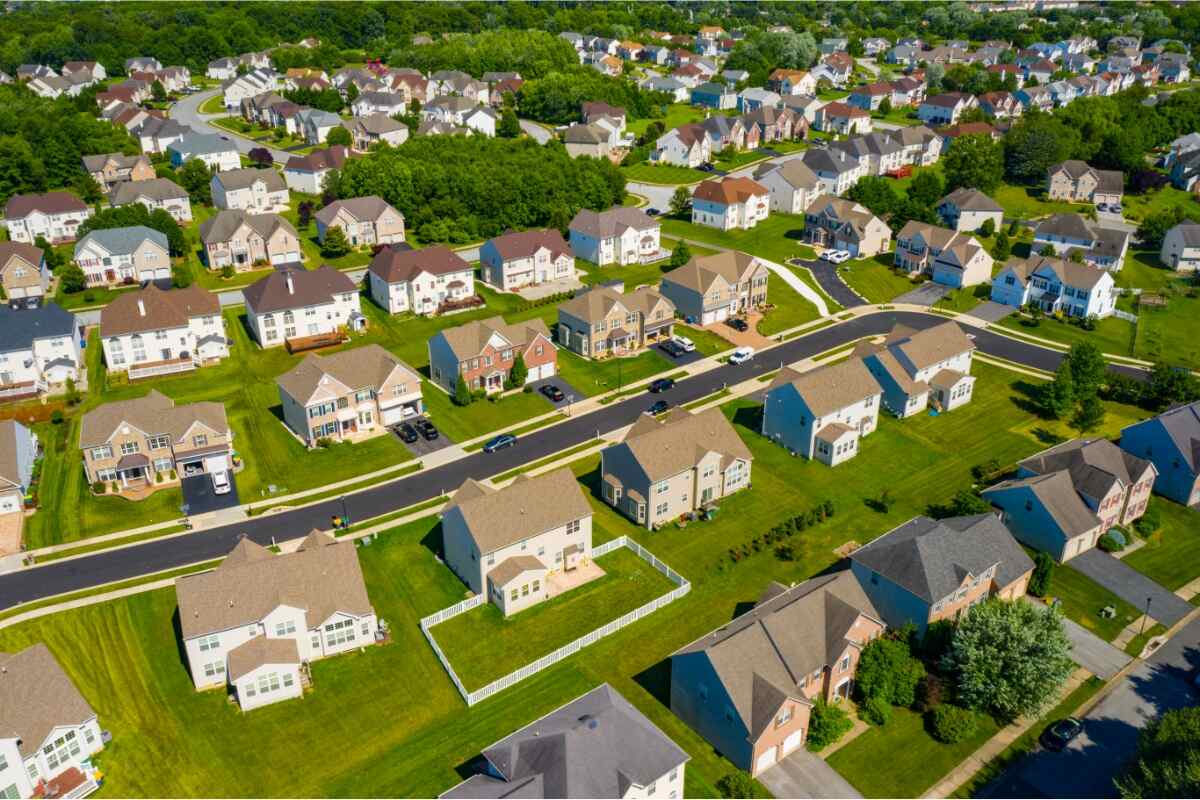
Located north of the turfgrass transition zone, the Diamond State is primarily cool-season grass territory. The best grass seeds for Delaware’s lawns include winter-hardy varieties like tall fescue, fine fescues, Kentucky bluegrass, ryegrass, and bentgrass.
Zoysia, a resilient warm-season grass, is also a good option, but more for the summer houses along the coast since it only stays green from May to September.
With the right type of grass on your lawn, maintenance is simpler, and your turf is better looking. Let’s learn more about the best grass types for Delaware and how to choose the perfect one for your property.
What Grasses Thrive in Delaware?
Bordered by the Atlantic Ocean and Delaware Bay in the east, the Diamond State sits north of the turfgrass transition zone. Its continental climate allows winter and summer grasses to grow in parks and home lawns, but cool-season grasses are the most popular and successful.
Cool-season grasses sprout early in the spring, thrive all the way through May or June, and go dormant during dry summer spells with temperatures over 85°F. They return to their green glory with Autumn rainfall, and they keep growing well into October before retiring to winter dormancy when temperatures go below 45°F.
Delaware’s winter temperatures are mostly too harsh for warm-season grasses. Of all warm-season grass types, Zoysiagrass gives the best results up here, and it’s tough enough to resist Delaware’s winter freezes. It loves the summer heat and makes lovely, emerald-green lawns for summer houses and bungalows along the coast for 4 to 5 months a year.
Best Cool-Season Grass Seeds for Delaware
Cool-season grasses, aka winter grasses, thrive when air temperatures range between 60 to 75°F during the day and stay in the mid-50s at night.
They go dormant when it is constantly colder than 45 – 50°F and begin to struggle in temperatures higher than 80 to 85°F.
The most popular cool-season grasses for Delaware lawns include tall fescue, fine fescue, perennial and annual ryegrass, and Kentucky bluegrass. Read on to see which is best for your needs.
1. Turf-Type Tall Fescue: Best Overall and for Full Sun Lawns
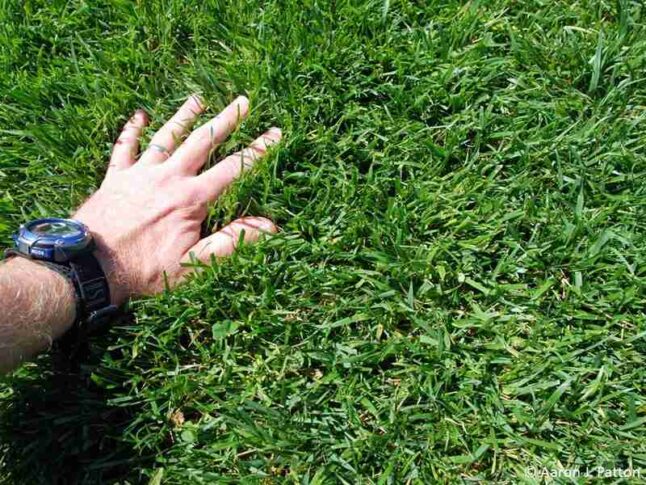
The last to brown out in the summer, tall fescue is the best choice for keeping a lawn green longer in the Diamond State. It forms dense, dark green clumps with broad, coarse leaves. Resilient to diseases and pests, tall fescue nevertheless has a weakness against brown patch disease if overwatered and overfertilized.
It deals well with drought and has moderate tolerance for heat. You can grow it under trees and shrubs that create light shade, and its high salt tolerance keeps it lush in coastal lawns across Lewes and Rehoboth Beach.
Establishing and growing tall fescue grass from seeds is slow, so you must be patient during the first year.
- USDA hardiness zone: 3 to 8.
- Established by: Sod and seed. Spread 6 to 8 pounds of grass seed per 1,000 square feet.
- Spreads by: It produces short rhizomes but has a bunch-type growth habit.
- Shade tolerance: Moderate.
- Drought tolerance: Moderate to High.
- Foot traffic tolerance: Moderate with fair recovery potential.
Maintenance:
- Mow every 5 to 7 days.
- Irrigate with one inch of water each week.
- It needs 2.5 to 3 lb. of nitrogen per 1000 sq. ft. per growing season.
- Does not produce significant thatch.
Main Characteristics:
- Mowing height: 2 to 4 inches.
- Potential for disease: Tolerant of most diseases when properly maintained.
- Soil pH: 5.5-6.5
- Soil type: Adapted to various soil conditions but prefers fertile clay soils with good drainage.
- Cultivars that thrive in Delaware: Spyder, Turbo, Catalyst, Faith, Toccoa, Stetson II, 3rd Millenium SRP, Firecracker LS, Pedigree, Falcon IV.
Grass Seed Options:
– Triple-Play Tall Fescue Grass Seed Blend (5000 sq ft)
– Eretz Kentucky 31 K31 Tall Fescue Grass Seed (choose your size)
– Pennington The Rebels Tall Fescue Grass Seed Mix (7 lb.)
2. Fine-Leaf Fescues: Best for Shady Lawns in Delaware
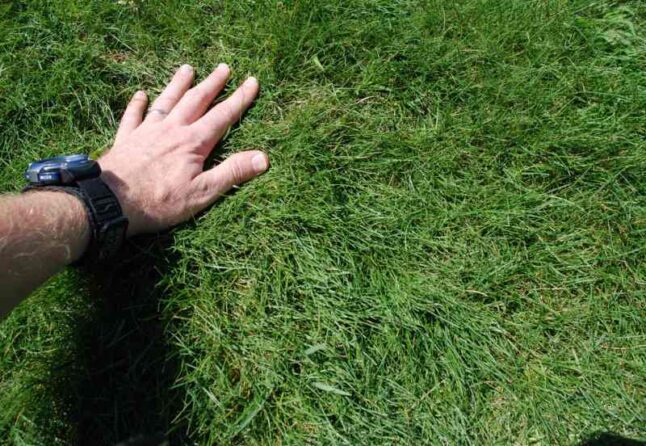
With thin, narrow, almost needle-like leaves, fine fescues are a tough type of grass growing in sandy, clay, and loamy soils (if well-drained). They tolerate shade, cold, salt, and drought conditions well and adapt easily to infertile and acidic soils. In Delaware, you’ll often see four varieties:
- Creeping red fescue
- Sheep fescue
- Chewings fescue
- Hard fescue
Fine-leaf fescues need less mowing and fertilization and are excellent for low-maintenance or shady lawns. They don’t tolerate full sun very well, so it’s best to use fine fescues in a mixture with ryegrass or Kentucky bluegrass on sunny lawns.
- USDA hardiness zone: 1 to 7 creeping red fescue, 4 to 9 hard fescue, 3 to 7 Chewings fescue, 4 to 9 sheep fescue.
- Established by: Seed. Spread 5 pounds per 1,000 square feet.
- Spreads by: Creeping red fescue spreads by rhizomes. Other fine fescues are bunch-type grasses, such as Chewings, hard, and sheep fescues.
- Shade tolerance: Moderate to High.
- Drought tolerance: Moderate to High.
- Foot traffic tolerance: Low to Moderate.
Maintenance:
- Low fertilizer and mowing needs.
- It requires 1 to 2 lb. of nitrogen per 1000 sq. feet per growing season.
- Minimal thatch forming.
Main Characteristics:
- Mowing height: 2.5 to 4 inches.
- Potential for disease: Moderate. Common diseases include red thread, leaf spot, dollar spot, summer patch, and powdery mildew.
- Soil pH: 6-6.5
- Soil type: Will not perform well in wet soil conditions with high fertility. Prefers drier soils and tolerates a wide range of soil types and fertility.
Grass Seed Options:
– Outsidepride Legacy Fine Fescue Grass Seed (5 lbs.)
– Eretz Creeping Red Fine Fescue Seed (choose your size)
– Outsidepride Creeping Red Fine Fescue Grass Seed (25 lbs.)
– Outsidepride Hard Fine Fescue Grass Seed (10 lbs.)
3. Kentucky Bluegrass: Best for Northern Delaware Lawns

Delawareans who aim for high-quality turf can make their dreams come true with Kentucky bluegrass. More cold-hardy than other cool-season grasses, Kentucky bluegrass fits like a glove to finely textured lawns in Wilmington, New Castle, and other cities in the northern part of the state.
Kentucky bluegrass varieties can be established from seed or sod. If you’re in a hurry, go for sod. Seeds take longer to convert into an established thick lawn.
This grass type finds its best growth rhythm in full sun, but you can plant it in partial shade in a seed blend with fine fescue.
- USDA hardiness zones: 3 to 9.
- Established by: Sod and seeds. Spread 3 pounds of grass seed per 1,000 square feet for a new lawn or 1.5 pounds per 1,000 square feet to overseed.
- Spreads by: Rhizomes.
- Shade tolerance: Low.
- Drought tolerance: Moderate.
- Foot traffic tolerance: Moderate.
Maintenance:
- Moderate mowing frequency.
- High fertilization needs. It requires 2-4 lb. Of nitrogen per 1000 sq. ft. per growing season.
- Prone to forming thatch.
Main Characteristics:
- Mowing height: Set the lawn mower blade height between 2.5 and 3.5 inches.
- Potential for disease: Moderate to high. It is prone to several diseases, such as dollar spot, leaf spot, necrotic ring spot, summer patch, and stripe smut.
- Soil pH: 6-7.5
- Soil type: Performs best in well-drained, heavy soils with high fertility.
Grass Seed Options:
– Jonathan Green (11970) Blue Panther Kentucky Bluegrass Grass Seed (3 lbs.)
– SeedRanch Midnight Kentucky Bluegrass Seed (5 lbs.)
4. Perennial Ryegrass: Best in Blends with Fine Fescue and Kentucky Bluegrass
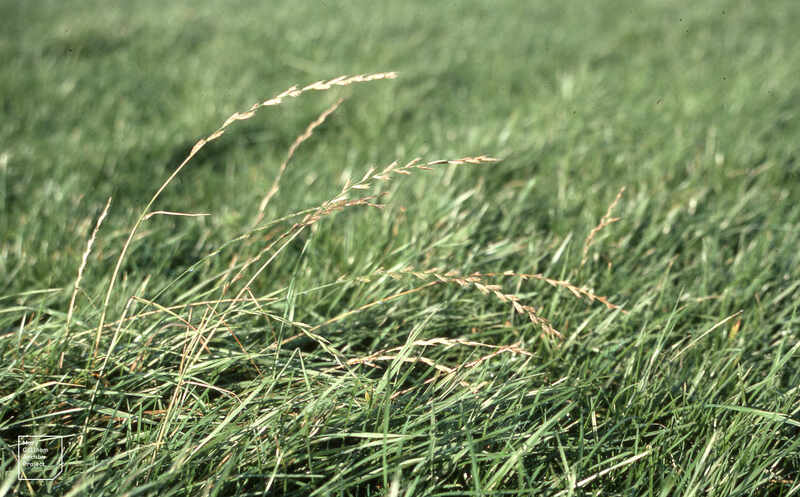
Perennial ryegrass has dark green, fine-textured blades. It looks excellent in a seed mixture with Kentucky bluegrass or fine fescue due to its similar appearance and rapid establishment.
In seed mixtures, ryegrass germinates first and creates a delicate green cover that makes the yard look nice while waiting for bluegrass or fine fescues to grow.
It can also fill in damaged patches without overseeding and has excellent traffic tolerance. Ryegrass handles heat well but is vulnerable to freezing in wet soil and windy conditions.
- USDA hardiness zone: 2 to 8.
- Established by: Seed. Spread 8 and 12 lbs per 1,000 square feet.
- Spreads by: Has a bunch-type growth habit
- Shade tolerance: Low
- Drought tolerance: Low
- Foot traffic tolerance: High
Maintenance:
- It has moderate mowing requirements.
- Fertilize with 1 to 5 lbs. of nitrogen per 1000 sq. ft. per growing season.
- Thatch is not significant.
Main Characteristics:
- Mowing height: 1.5 to 2.5 inches
- Potential for disease: High. Common diseases include gray leaf spots, red thread, and leaf spot/melting-out.
- Soil pH: Can grow in soils with a pH between 5 and 8 but prefers between 6 and 7.
- Soil type: Prefers good drainage and fertility but can tolerate poor drainage.
Grass Seed Options:
– Outsidepride Perennial Ryegrass Seed (5 lbs.)
– Eretz ProTurf Perennial Ryegrass Fine Lawn Seed (choose your size)
5. Creeping Bentgrass: Specialty Grass Best for Golf Courses and Athletic Fields
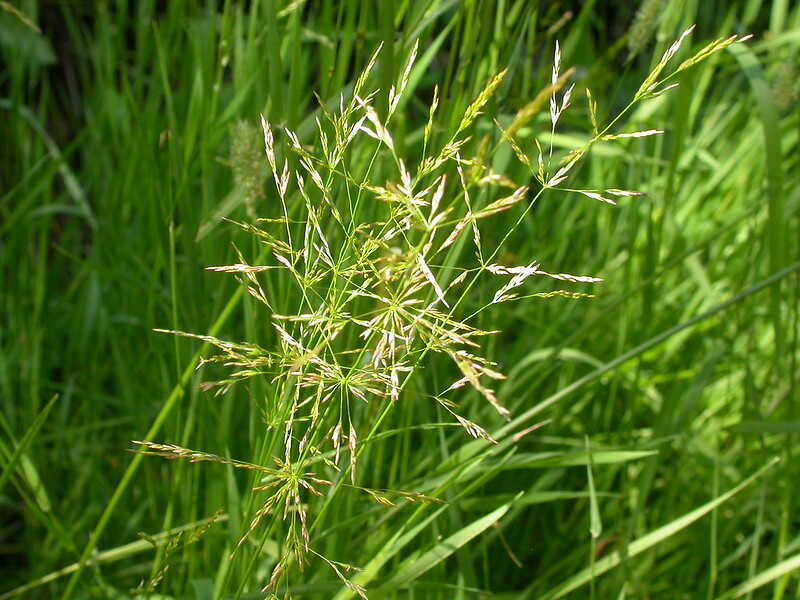
Fine-textured leaves of bright green color and a low mowing height make creeping bentgrass a cool-season specialty for Delaware’s sports fields and golf courses – but not so much for home lawn landscaping.
Growing a shallow mat-like root system, creeping bentgrass requires frequent watering, fertilization, and mowing. It is a high-maintenance grass and a headache to keep neat and green during the summer heat without professional help. Bentgrass is also prone to heavy thatch and becomes invasive if improperly managed.
- USDA hardiness zone: 3 to 9.
- Established by: Sod is the easiest method. Seeds take up to 2 weeks to germinate.
- Spreads by: Stolons
- Shade tolerance: Moderate
- Drought tolerance: Low
- Foot traffic tolerance: Moderate
Maintenance:
- Requires frequent watering, fertilizing, dethatching, and mowing.
Main Characteristics:
- Mowing height: Set the mowing height between 0.5 and 0.125 inches.
- Potential for disease: High disease potential. Common infections include dollar spot and brown patch disease.
- Soil pH: 5.5-6.5
- Soil type: Prefers moist soils with good drainage.
Best Warm-Season Grass Seeds for Delaware
Also known as summer grasses, warm-season grasses thrive when temperatures range between 80 and 95°F during the day and stay over 75°F at nighttime. The most popular summer turfgrasses grown across the U.S. are Bermudagrass, Zoysiagrass, centipedegrass, and Bahigrass. Zoysia offers the best results in Delaware due to its superior cold tolerance.
Zoysiagrass: Best for Summer Lawns in Delaware
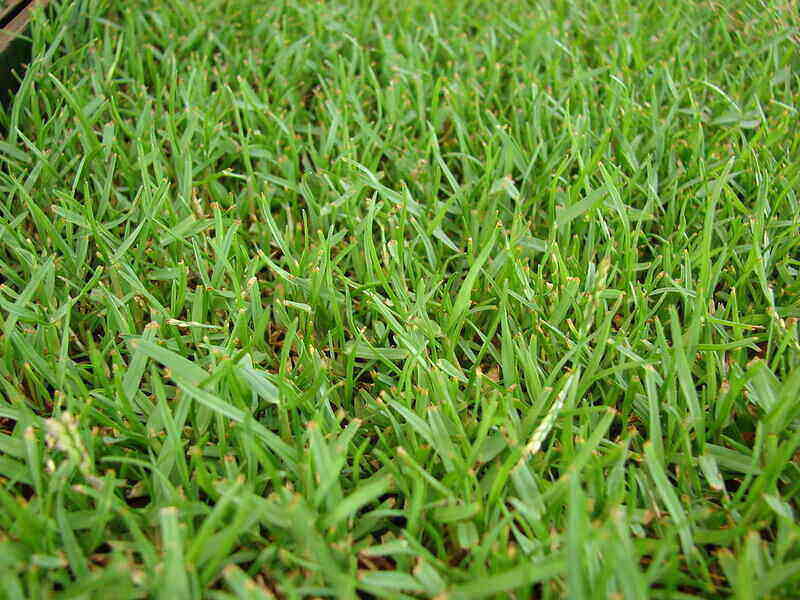
Needing heat and sun to thrive, Zoysiagrass is more suitable for the southern and eastern coastal regions of Delaware (i.e. Georgetown, Milton, Bethany Beach). It covers the ground in a beautiful emerald green, with medium-coarse blades and a good tolerance to salt, drought, and shade. It also withstands heavy traffic due to its robust stolons that spread over the lawn.
On the downside, it has an aggressive growth habit that can get you in trouble with your neighbors and stays green in Delaware only for about 4 to 5 months a year.
It’s an excellent fit for summer homes along the beach in Lewes, Fenwick, or Rehoboth, where a green, lush carpet during the warm months is enough. But, it’s not so good for year-round permanent lawns.
- USDA hardiness: 5 to 11.
- Established by: Sod or seed. Spread 2 pounds of seed per 1000 square feet.
- Spreads by: Stolons and rhizomes
- Shade tolerance: Moderate
- Drought tolerance: Moderate to High
- Foot traffic tolerance: High, but recovers slowly from damage.
Maintenance:
- Moderate nitrogen fertilization requirements. Spread 2 to 4 lbs. Of nitrogen per 1000 sq. ft. per growing season.
- However, it’s prone to thatch build-up.
Main Characteristics:
- Mowing height: 1 and 2 inches.
- Potential for disease: Good disease tolerance overall.
- Soil pH: 6-6.5
- Soil type: Well-draining, some cultivars are more tolerant of a wide range of soils than others.
Grass Plug and Seed Options:
– Zoysia Plugs (50 Large Grass Plugs)
– Zoysia Plugs (50 Full & Lush Grass Plugs)
– Zoysia Plugs (100 Plugs)
– Zenith Zoysia Grass Seeds (1/8 lb. of seeds)
How to Plant Grass Seed in Delaware
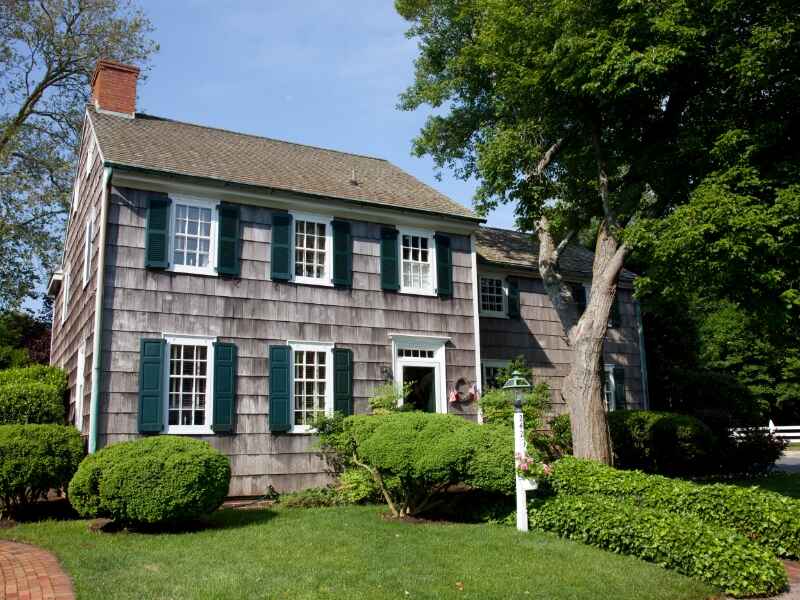
The best time to seed cool-season grasses in Delaware is late summer or early fall (around August 15 to September 30).
This is when soil temperatures range between 50 to 65°F, still warm enough to promote fast germination. At the same time, approaching freezes will wilt annual summer weeds by late fall, reducing competition for nutrients, light, and water.
The second best time to seed cool-season grass in Delaware is between March 1 and April 15 in the spring.
Sod can be installed at any time during the year if you provide enough moisture for proper rooting.
How to Prepare for Planting Grass
With either seeds or sod, you’ll get the best results when preparing the site thoroughly. Here’s how:
- Remove fallen branches, sticks, stones, toys, and other debris from the lawn. Rake fallen leaves and thatch.
- Get rid of weeds. Hand-pull or apply a systemic herbicide to kill the plants and roots. Wait at least 30 days before seeding or laying sod.
- Test the soil and improve pH.
- Spread 2 to 4 inches of organic matter and till into the ground.
- Spread starter fertilizer if needed, and rake it into the topsoil.
How to Spread Grass Seed
Choose a grass type or mix of different grass types and use this calculator to estimate the amount of grass seed you’ll need for your lawn. To get the best coverage, follow these steps:
- Spread the seed uniformly across the soil, going back and forth and perpendicular to the initial direction.
- Rake the soil to cover the seed or spread a thin layer of topsoil.
- Cover with mulch to keep moisture and protect the seed from birds.
New lawn care is all about keeping the soil moist until germination. Prepare to water daily, but consider spring rainfall to avoid soaking the ground.
How to Install Sod
To install sod, start by lightly watering the soil until it’s moist. Lay the sod pieces on the ground and push them together to cover any cracks. Tamp the soil lightly and spread topsoil on the seams to promote rooting.
You can also hire a local lawn care company to install the sod professionally.
How to Overseed Grass in Delaware
A thick, healthy lawn is the best defense against weeds, diseases, and pests. Exposed to stress in winter and summer, the Diamond State’s lawns need overseeding two times a year: spring and fall.
Include overseeding in your regular lawn care program to get the best results. Schedule it after lawn cleaning, aeration, and dethatching. This way, you’ll work with a clear soil surface where seeds can easily land and take roots.
Like when seeding a new lawn, rake some soil over the seeds and spread a layer of mulch to protect them from drought, wind, and birds.
Pro tip: Use a broadcast spreader to ensure uniform distribution of seeds. You can purchase a broadcast spreader from Amazon, Home Depot, Lowe’s, or wherever you buy your lawn care tools.
Overseeding is just one part of keeping your lawn green and healthy. For more detailed lawn advice, see our lawn care tips for Delaware.
FAQ
Kentucky bluegrass, perennial ryegrass, and Zoysiagrass are the best turfgrasses to plant in full sun in Delaware. Note that Zoysia will only thrive in the summer and in the southern and coastal parts of the state.
Chewings fescue, tall fescue, perennial ryegrass, hard fescue, and red fescue have the best tolerance for shade among the cool-season grasses to consider for Delaware.
They are often available in grass seed mixes created for shady areas. Zoysiagrass is a warm-season option for lawns with shade trees or between buildings.
Endophytic cultivars of grass seed contain a beneficial fungus that makes them more resilient to stressful conditions such as low watering and poor soil. They also improve resistance to some foliar pests.
Northern Delaware is in USDA hardiness zone 7a, with winter temperatures reaching 0 to 5°F, while the coastal area of Sussex County is in zone 7b with minimums of 5 to 10°F.
To find plants for your landscape that will thrive in Delaware’s hardiness zones, explore some of Delaware’s best native plants.
Start Your Lush Delaware Lawn Today!
Your cozy Delaware home deserves a lush, green lawn you can easily keep healthy and thick. The secret to getting it is choosing the right seeds from the start.
Don’t hesitate to ask a pro for advice if deciding among the top grasses and seed mixes is challenging. Contact a local lawn care company and make an appointment! LawnStarter has experienced lawn care professionals throughout the state, from northern Wilmington, Newark, and New Castle to the south sandy beaches.
Main Photo Credit: felixmizioznikov / Canva Pro / License
LawnStarter participates in the Amazon Services LLC Associates Program and other affiliate advertising programs. LawnStarter may earn revenue from products promoted in this article.